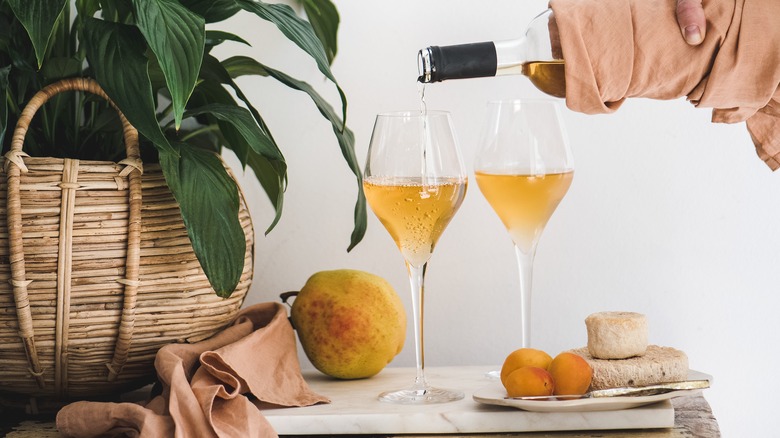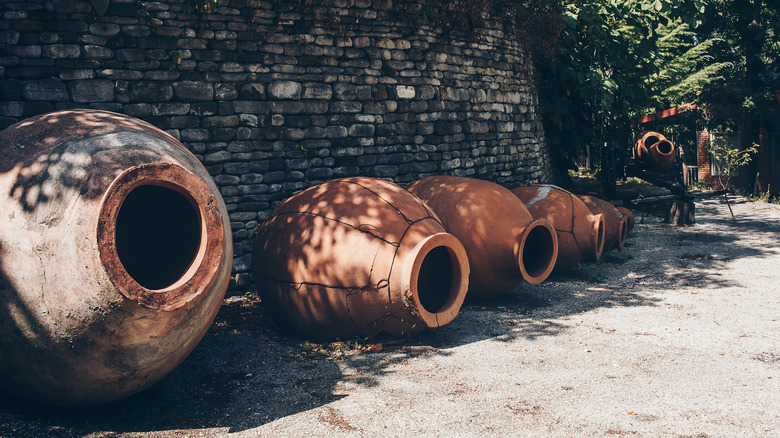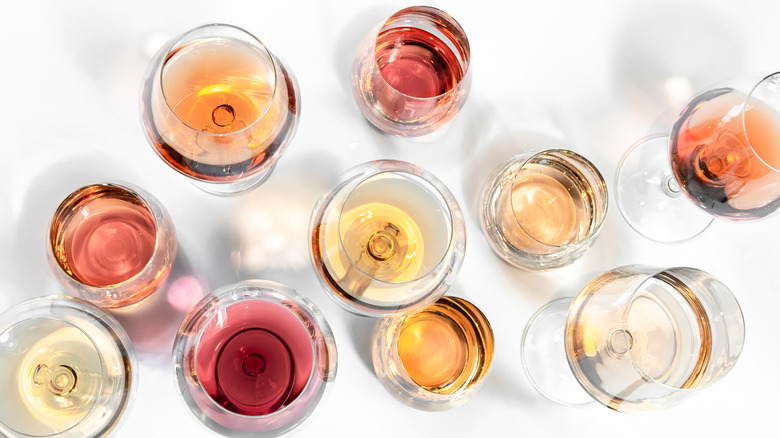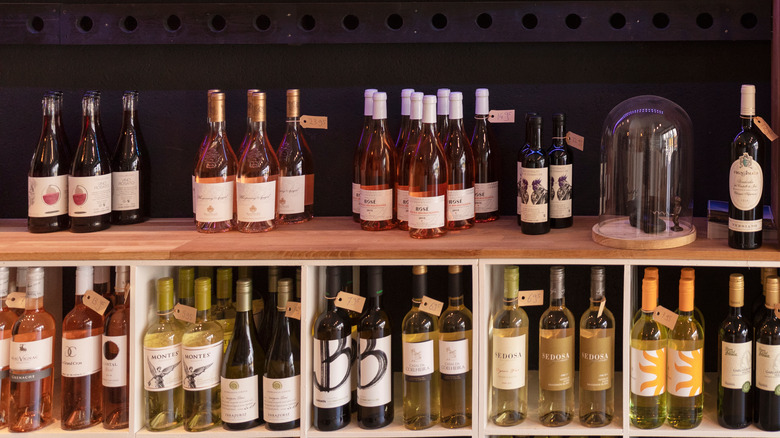What Is Orange Wine And Does It Contain Citrus?
If you've heard of orange wine, you've probably wondered if it's made from oranges or even tastes like oranges. In truth, its name is just in reference to its slightly orange hue, although even the color varies from pale yellows to vibrant amber. So no, it contains no citrus: this type of wine is actually made from white wine grapes. But unlike white wine production, where they are peeled before they're pressed and fermented, orange wine is made with white wine grapes with skin and seeds attached — hence the more accurate term is skin contact wine. Orange wine gets its rose-tinted hue from the skins and seeds of these grapes, which are included in the fermentation cauldrons.
Not only do the seeds and skins give the wine a peachy glow, but they also imbue a slightly tannic mouthfeel, making orange wine almost like an in-between of red and white wine. However, a distinction in orange winemaking is that it is sealed off completely to limit oxygen exposure, giving it a uniquely fermented, fruity quality. Although this all-natural wine seems like the cool new kid in town, it's actually older than the white wine we're so familiar with.
The history of orange wine
Like many supposed food trends, orange wine has been a tradition in its country of origin, Georgia, for several millennia. The orange wine-making process is ancient, dating back over eight centuries in the Caucasus, where present-day Georgia is located.
The wines were fermented in large clay pots called qvevri, which sealed the mashed grapes (skins, seeds, and all) in an airtight space in the ground for days. With sufficient temperature control and a properly enclosed space, the grapes were fermented without the addition of yeast and sugars, making it an all-natural production process. While it stayed in the country's tradition for centuries, orange wine was eventually overtaken by industrialized wine production when the USSR annexed the country in the 1920s. Luckily, the traditional practice resurfaced a few decades ago when it became popularized in Italy in 1997. Neighboring countries like Slovenia, Croatia, and Italy borrowed these fermentation processes from traditional Georgian wine producers, eventually becoming major exporters of orange wine.
The recent resurgence of orange wine in trendy wine bars can be attributed to the constantly fluctuating trends of the wine industry. While it's been quite some time since people would dismiss natural wine fans as being pretentious, natural wine never really left store shelves. And it seems that orange wine on its own occupies a wholly different market demand for people who seek something both natural and "funky." Interestingly enough, "funk" is a popular descriptor for the wine's flavor profile, although it might not be accurate.
What does it taste like?
Given its name, you can imagine the wine has citrusy notes, or if you're familiar with its reputation, you probably assume it's "funky." Many compare it to sour beer or describe it as tropical fruit with strong odors like jackfruit. However, like all types of wines, orange wine has a wide range of flavors and varying levels of intensity. The lighter the orange wine, the less potent the sour aroma. In fact, orange wine can also be sweet and mellow like white wine — but more on that later.
The real distinction between orange, red, and white wine is indeed the number of tannins present. Tannins, which are the dominant flavor of red wine, come from the seeds and skins of the wine grapes. They're responsible for the dry and almost woodsy aroma and mouthfeel of red wine. Since it's produced sans grape seeds and skins, white wine has no tannins, while orange wine does.
As its appearance indicates, orange wine is almost an in-between of white and red wine. It has the flavors of white wine grapes with the sour and dry mouthfeel of red wine due to the fermented skins and seeds. But what about rosé, which is almost identical in appearance?
Orange wine vs. Rosé
Somewhere along the way, rosé seems to have lost its sparkling allure in wineries and hipster dining establishments alike. It's been too closely associated with the sugary, cheap wines purchased for a girl's night in, used as a base for a Frankenstein's monster of a strawberry sangria. In truth, rosé is just as sophisticated as orange wine. Sure, they look very similar, but there is a huge difference in the way they're made and what they're made from.
Red wine grapes are specifically used for red wines due to their delectably rich skins and seeds, which imbue the drink with polyphenols and a deep ruby hue. White wine grapes, on the other hand, are usually peeled and deseeded for white wine production, making for a lighter, sweeter wine. Out of these two variants of wine grapes are some inbetweeners: rosé and orange wine. Rosé is what occurs when you attempt to make a white wine out of red wine grapes, peeled and deseeded. Orange wine is the product of using the entire grape with the skins with white wine grapes. This means that all red wines are essentially "skin contact" wines, although orange wine distinguishes itself since it's made from a different type of grape.
The noticeable gulf between the two wines' reputations is probably due to the apparent novelty of orange wine. The tradition of orange winemaking is also untouched by market demands as of now, which means quality is guaranteed by the label.
What food pairs well with orange wine?
Due to the variety of orange wines available in the market, it's safe to say that it's a versatile alcohol that can be paired with just about any dish. Although there are classic wine pairings — like tannic red wines with aged cheeses — orange wines have varying levels of tannins that make them suitable for many different kinds of cheese (in general, high-tannin wines go better with aged cheeses and vice versa). Mild cheeses like burrata, which are creamy and soft, or sharp parmesans, would all taste wonderful with orange wine. It really depends on how light or dark your orange wine is, since the lighter ones tend to be more reminiscent of classic white wines.
Gamey meats like lamb also complement the wine well, with its slight tartness and dry mouthfeel. Since the flavor of orange wine is often compared to a sour beer, the dryer orange wines can also be refreshing in-between bites of fried chicken or anything deep-fried, for that matter. Some believe that the funkiness of the wine itself goes well with foods that are equally — if not more — "funky" or pungent, like kimchi or sauerkraut. Of course, while the two flavor profiles are similarly tangy and fermented, they can be overwhelming on the palate for some. You can also have orange wine with barbecued meats or grilled seafood like octopus, which is salty and heavy.
Where to buy it
While orange wine has become increasingly popular over the last decade, it is a still bit harder to find at your local grocery store or liquor store. Some liquor stores with a wider selection of wines may carry a few orange wines, but it's best to look for wine stores near you. Most wine bars should carry orange wines, and it is likely that some snazzy restaurants would also have a small selection.
If you're on the hunt for a specific orange wine, though, it's best to purchase it from an online wine retailer. If you don't have a BevMo! or Total Wine & More store near you, you can order from them online and have a bottle shipped to your house within a few days. Primalwine, Vivino, and Wine.com are also online stores that will most likely offer the exact bottle of skin-contact wine you're looking for.
The best orange wines to try
There are tons of great orange wines on the market, each of them with different scents, flavors, and aromas. Whether you're looking for something light or deeper and dryer, there is an orange wine for you.
If you usually go for acidic, sweet whites, See Saw 'SAMM' Orange Wine 2021 (Australia, $31.99) is a light blend of Sauvignon Blanc and Marsanne. This skin-contact wine is made via carbonic maceration, which means its tannins are softened, giving it more fruity flavors. The main tasting notes are pineapple and vanilla bean.
Meinklang Mulatschak Orange 2021 (Austria, $28.95) is a classic choice made from a blend of Welschriesling, Pinot Gris, and Savagnin grapes. The grapes are left to ferment for around seven days, giving this orange wine a faint amber hue, with tasting notes of peach and apricot.
Want something more tannic? Teliani Valley Amber Blend 2019 (Georgia, $21.99) is a blend of Georgian grapes Rkatsiteli, Kakhuri Mtsvane, Khikhvi, and Kisi, which are left to ferment for six months. You'll taste spice, orange rind, and peach in this deep amber wine. If you're typically a red wine lover, this one will give you a satisfying full-bodied taste, along with a citrus touch.
Iapetus Tectonic 2021 (USA, $35.99) is another bold orange wine with a bold finish of raisin, white pepper, apricot, and floral notes. This tangy wine pairs well with various cheeses, nuts, and oysters.
How to store it
Most white wines are chilled for an optimal effervescent touch or a sweet and refreshing flavor. Red wines, on the other hand, are enjoyed at room temperature so that you may experience the woodsy aromas and the full body of the tannins. So what about orange wine? Well, since orange wines have a wide range of flavors and tannic levels, it really depends on what kind of orange wine you have. The darker, amber-toned orange wines really benefit from being enjoyed at room temperature. Chilling them ever so slightly at 53 to 57 degrees F and then bringing them out a few minutes before serving is the sweet spot. You'll experience both a slightly cool drink while tasting the full depth of the dry and fruity wine.
There are also more acidic variants of orange wines, which are light, tart, and sometimes sweet. These types of orange wines are delightful when chilled at lower temperatures around 50 to 53 degrees F. Natural sparkling wines tend to be lighter in color and tannins, which means they usually have more sweet and citrusy aromas. However, if you chill them too much, it could hide their oxidative notes, which is why you should let orange wines sit for a little to get the most out of them.







